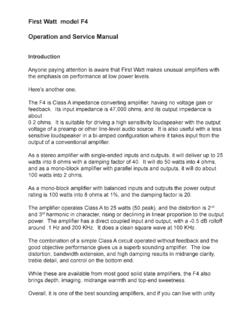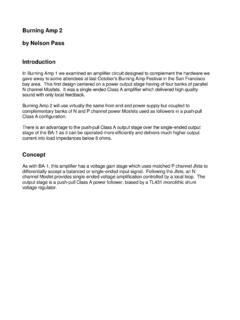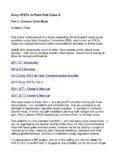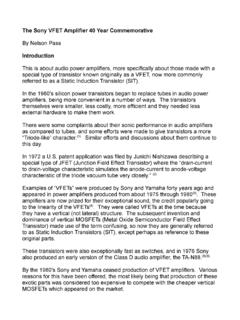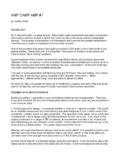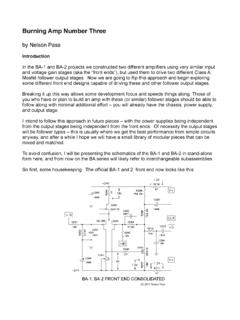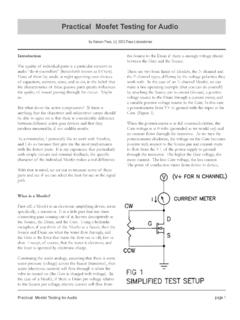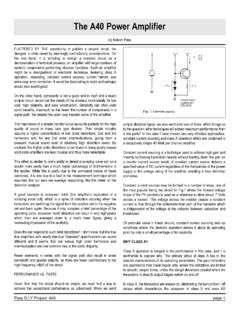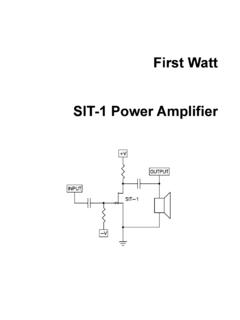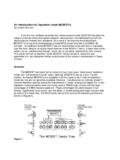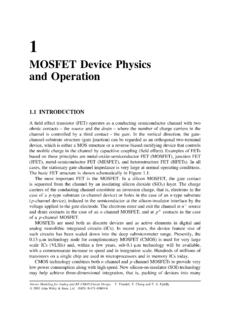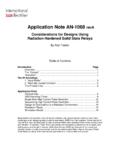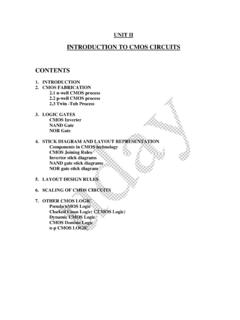Transcription of De-Lite Amplifier - FIRST WATT
1 De-Lite Amplifier by Nelson PassIntroductionThe third annual Burning Amp Festival was held in San Francisco last October, drawing a couple hundred DIY Audio enthusiasts, many from long distances. At previous BAF gatherings I have simply brought a truckload of parts that might appeal to DIYers, but this year an announcement went out that I would have a presentation. It was news to me, but a quick talk is a lot less effort than hauling a ton (literally) of parts, so I decided to pretend it was my idea. Procrastination being as much a part of my life as anyone else's, I found myself two days before the event having nothing prepared. What better opportunity to throw together something totally easy for of you have never built an Amplifier , and this article is intended to get you to do it.
2 One of the biggest problems helping people to take the leap into building their own electronics is offering something really easy but satisfying a simple but exotic project with low barriers and cheap power Amplifier is just such a piece of low hanging 33 years of creating DIY projects I recall that one of the most popular was 1997's Son of Zen ( ), a single-stage no-feedback Class A design using two N channel Mosfets arranged as a single balanced differential pair. It remains one of the simplest amplifiers I have written Pass-DIY Gallery has examples of SOZ amplifiers, usually featuring totally over-the-top metal work and giant heat sinks and power resistors more so than other designs.
3 Apparently there is a breed of he-man DIYers who can saw, machine, drill, bend, glue, weld, bolt, cut, and solder with confidence but who break into a sweat when confronted with the three legged here's an Amplifier that carries some marketable buzz words: Depletion-mode FET, Single-ended Class A, no negative feedback, current source output and glows in the dark. And only one Simplest AmplifierI wanted an Amplifier easy enough to lure unsuspecting audiophiles away from blind consumerism and down the slippery slopes of DIY on the Thursday night before BAF I took my scrappiest piece of wood and glued a heat sink and transformer to it and let it sit overnight.
4 Halfway done - just like that!The following afternoon I populated it with screw-on terminal blocks, power cord, fuse, diode bridge, two big electrolytic capacitors, a one ohm power resistor, two 300 watt light bulbs (with sockets), two RCA connectors, two smaller electrolytic capacitors, two small resistors and two power Mosfet hour of point-to-point wiring, and Voila! A stereo power Amplifier . Figure 1 shows what it looked like at Burning Amp Festival:(photo courtesy of Dana Brock)You see that it glows comfortingly and does not require an on 2 shows the schematic with the supply and one of the two channels:Nothing magical about the supply I chose a CRC filter configuration to take out some of the voltage ripple and get the noise down a bit.
5 The diode bridge, power resistor, and Mosfets should be mounted on the heat sink as seen in Figure 1, as they dissipate quite a bit of heat. R1 is going to dissipate as much as 20 watts, and the Mosfets will dissipate as much as 55 watts each, so don't scrimp on the heat sinking. If you choose to build this Amplifier and its variations as a monoblock, then you can get away with less, but don't fool around. The power transformer should be rated at at least twice the actual draw, so you should figure on 350+ VA rating per used power supply capacitors at 25,000 uF, but feel free to use more. Maybe lots more. The supply voltages we will be seeing start at 65 volts and go as high as 100 volts DC, so it will be good to get caps rated at this.
6 The rectifier bridge is a standard 35 amp 400 volt type, a very common part. Perhaps you will want to try those snazzy fast/soft recover diodes you read about, but save it for supply is the bare minimum, but it will get the job done, and you can improve on it in your free time. Remember SAFETY FIRST use a fuse and insulate the AC line connections. Try not to start a fire or electrocute anyone. The article Zen Variations #3 is a decent start if you want to explore power supply issues and safety Mosfet will develop its output across a 300 watt (120V) light bulb which I bought from McMaster-Carr along with some sockets. The clear glass ones look the best.
7 The output capacitor C3 protects the speaker from the DC voltage seen at the Drain pin of the Mosfet. If your speaker drivers are capacitively coupled already by a crossover filter, you might eliminate this capacitor, and of course you can use a better capacitor than my 10,000 uF 50V electrolytic. 1,000 uF of polypropylene capacitance will get you down to around 30 Hz or so, and larger values will get you lower, if you can afford output impedance of the Amplifier is essentially that of the light bulb, which is about 20 ohms or a little more, depending on the DC voltage across it. If you want, you can easily substitute a 16 to 25 ohm power resistor instead of the light bulb, but it's not as much fun or attractive in the input resistor R3 to ground gives the Gate a DC connection to ground, so that you don't depend on the preamp to provide this and the Mosfet doesn't start acting strange.
8 If you know your preamp has this and you're not a scaredy-cat, then you can do without it. With it, the input impedance of the Amplifier is essentially the value of this resistor, which is not amp worked the FIRST time I plugged it in, and Figure 3 shows the distortion curve:2 watts of power into 8 ohms with about 10 percent distortion (I've seen worse).I hooked it up to a pair of full range speakers in open baffles and gave it a listen: On the plus side, it has plenty of gain. On the minus side, the 2nd harmonic distortion is high, even at low power. If you own efficient speakers (like 93 to 100 dB/watt) and listen to simple music (a vocal and guitar for example), then this amp might take care of you, but it will get congested pretty quickly with orchestral the meantime it does play music, and you can spend some quality time educating your ear and learning a bit about it before we take up a soldering iron to make it the way, please note that the circuit as presented has a rather large turn-on and turn-off thump.
9 You can power it up and down slowly with a Variac, or you can short the output terminals to ground during turn-on and turn-off (I used clip leads) so as to protect delicate drivers. The Variac solution is a particularly good one, as it allows you to adjust the voltage easily, and we will be doing some of that later. There are some decent ones starting at $49 at and if you're going to get addicted to building power amps you might as well get this purchase over with. Note that there is no input static protection, so exercise a little care when connecting your preamp to the input. Also, there are no gate stopper resistors on the Gate pin of the transistors.
10 If by chance your Mosfet looks like it's misbehaving, then 47 ohms or so in series with the Gate might be Mode MosfetsThis transistor is an unusual part, the Ixys IXTH20N50 depletion mode Mosfet. I got them from Digikey for about 6 bucks (and I had to buy 60). If you don't want 60 of them, then look around or check the group buys at 's a reason to try depletion mode Mosfets instead of usual enhancement mode devices. Mosfets conduct current based on the relative voltage between the Gate and Source pins. N channel Mosfets (like this one) conduct more current as the Gate becomes more positive with respect to the Source. In enhancement mode N channel Mosfets, the transistor is turned off when the Gate is at the same voltage as the Source.
